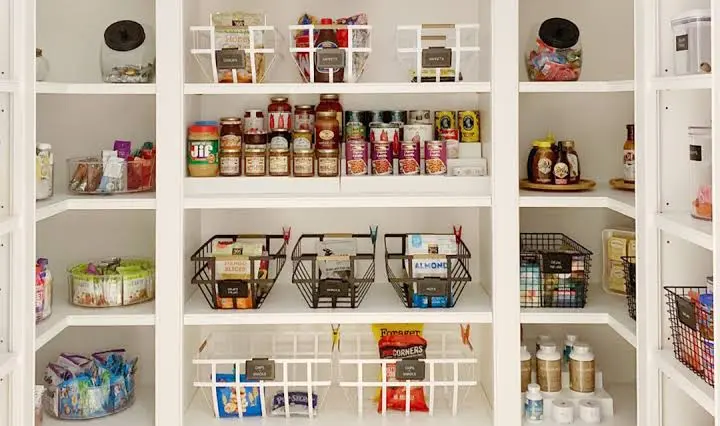Welcome to our Efficient Cabinet Organization Guide! If you’re tired of opening your cabinets only to be greeted by a jumble of items and a lack of space, then you’ve come to the right place. Here at Project Neat, we will explore the importance of efficient cabinet organization and provide you with strategies, tips, and tricks to help you achieve a clutter-free and functional cabinet space.
Understanding the Importance of Efficient Cabinet Organization
Efficient cabinet organization goes beyond just aesthetics. It plays a crucial role in improving your daily life by saving you time, reducing stress, and increasing productivity. Knowing exactly where each item is stored and having easy access to them can make cooking, getting ready in the morning, or finding important documents a breeze. Additionally, an organized cabinet prevents items from getting lost or forgotten, thus saving you money by avoiding unnecessary repurchases.Strategies for Effective Cabinet Cleaning
Before diving into organizing your cabinet, it’s essential to start with a clean slate. Regular cleaning not only keeps your cabinet looking its best but also ensures that your items are stored in a hygienic environment. In this section, we will discuss why regular cleaning is essential, the required cleaning supplies, and the steps for thorough cleaning.Organizing Your Cabinet Efficiently
Once your cabinet is clean, it’s time to tackle the organization process. We will guide you through categorizing your items, implementing organizational tools, and maximizing space and accessibility. By implementing these strategies, you’ll be able to create a logical and efficient system that suits your needs.Maintaining Your Cabinet Organization
Maintaining an organized cabinet is an ongoing process. In this section, we will provide you with tips on regular inspection and reorganization, consistent cleaning habits, and effective storage practices. By following these maintenance practices, you’ll be able to sustain the efficiency and organization of your cabinet in the long run.Special Tips for Different Types of Cabinets
Lastly, we will provide you with special tips for organizing different types of cabinets, including kitchen cabinets, bathroom cabinets, home office cabinets, and garage cabinets. Each type of cabinet has unique needs and requirements, and we will address them individually to help you optimize their organization.An efficiently organized cabinet not only enhances the aesthetics of your space but also brings convenience and functionality to your daily life. Make the time to organize your cabinets, or hire a professional organizer to get the job done. You will thank yourself later! Let’s dive in and transform your cabinets into an organized haven!Understanding the Importance of Efficient Cabinet Organization
Efficient cabinet organization is more than just a matter of tidiness. It has a significant impact on your daily life and overall well-being. Let’s delve into the importance of efficient cabinet organization and explore the benefits it brings:- Time-saving: How often have you wasted precious minutes searching for a specific item in your disorganized cabinets? Efficient cabinet organization saves you time by providing a designated spot for each item, making it easy to locate what you need quickly. No more rummaging through cluttered shelves or digging through piles of items.
- Reduced stress and frustration: A cluttered cabinet can be overwhelming and frustrating to deal with. It adds unnecessary stress to your daily routine, especially when you’re in a rush. When your cabinets are organized, you’ll experience a sense of calm and peace, knowing exactly where to find everything you need.
- Increased productivity: An organized cabinet allows you to be more productive in various aspects of your life. Whether it’s cooking in the kitchen, getting ready in the bathroom, or working in your home office, having a well-organized cabinet ensures that you have easy access to the tools, ingredients, or supplies you need. This streamlines your tasks and enables you to work efficiently.
- Prevention of wasted money: How many times have you bought something only to realize later that you already had it buried somewhere in your cabinet? Efficient organization prevents duplicate purchases, saving you money in the long run. By knowing exactly what you have and where it is stored, you can avoid unnecessary expenses.
- Improved hygiene and cleanliness: Regularly organizing and cleaning your cabinets helps maintain a hygienic environment. Dust, dirt, and food crumbs can accumulate over time, leading to potential health hazards. By keeping your cabinets clean and organized, you create a healthier and more pleasant space.
- Enhanced aesthetics: An organized cabinet improves the overall appearance of your living space. Imagine opening your cabinet doors to reveal neatly arranged items, labeled containers, and a clutter-free environment. It not only provides a visually pleasing experience but also enhances the overall ambiance of your home or workspace.
- Optimized storage space: Efficient cabinet organization maximizes the available storage space. By utilizing organizational tools, such as dividers, bins, and racks, you can make the most of every inch of your cabinet. This allows you to store more items in a compact and organized manner, avoiding wasted space.

Strategies for Effective Cabinet Cleaning
Keeping your cabinets clean is an essential step in maintaining an organized and hygienic space. In this section, we will discuss various strategies for effective cabinet cleaning. By following these strategies, you can ensure that your cabinets remain spotless and free from dirt, dust, and grime. Let’s dive into the details:- Why Regular Cleaning is Essential
- Understanding the importance of regular cabinet cleaning
- Preventing the build-up of dirt, dust, and food particles
- Eliminating potential health hazards and allergens
- Required Cleaning Supplies
- Essential cleaning supplies for cabinet cleaning
- Non-abrasive cleaners and solutions
- Soft cloths, microfiber towels, or sponges for wiping surfaces
- Cleaning brushes or toothbrushes for hard-to-reach areas
- Vacuum cleaner or dusting tools for removing debris
- Steps for Thorough Cleaning
- Emptying the cabinet and removing all items
- Wiping down the interior surfaces with a damp cloth or appropriate cleaner
- Cleaning shelves, drawers, and compartments individually
- Paying attention to corners, edges, and crevices
- Cleaning cabinet doors, handles, and knobs
- Drying the cabinet thoroughly before restocking items
- Dealing with Stubborn Stains or Grease
- Effective methods for removing tough stains or grease
- Using vinegar, baking soda, or specialized cleaners for stain removal
- Gentle scrubbing techniques to avoid damaging surfaces
- Applying heat or steam for grease removal
- Preventing Future Build-up
- Tips for maintaining a clean cabinet on a regular basis
- Wiping spills or stains promptly
- Regularly dusting or vacuuming cabinet interiors
- Using shelf liners or protective mats to prevent damage
- Implementing a cleaning schedule or routine
Organizing Your Cabinet Efficiently
Now that your cabinets are clean and ready, it’s time to focus on organizing them efficiently. In this section, we will provide you with strategies and tips to help you categorize your items, implement organizational tools, and maximize space and accessibility within your cabinets. Let’s get started:- Categorizing Your Items
- Assessing the contents of your cabinet and determining categories
- Grouping similar items together for easy identification
- Considering frequency of use when categorizing
- Implementing Organizational Tools
- Utilizing containers, bins, or baskets to keep items organized
- Choosing clear or labeled containers for easy visibility
- Using drawer dividers or shelf organizers to maximize space
- Installing hooks or racks for hanging items such as utensils or mugs
- Maximizing Space and Accessibility
- Arranging items based on frequency of use and accessibility
- Stacking or nesting items to save space
- Utilizing vertical space by installing additional shelves or risers
- Considering adjustable shelving for versatility
- Using pull-out drawers or sliding organizers for easy access to items at the back
- Labeling and Identifying
- Labeling containers or shelves to easily locate items
- Using clear or transparent labels for visibility
- Implementing a labeling system that works for you
- Adding inventory lists or tracking systems for better organization
- Maintaining a System
- Regularly reassessing and reorganizing your cabinet as needed
- Returning items to their designated spots after use
- Encouraging household members to follow the organization system
- Periodically decluttering and removing unused or expired items
Maintaining Your Cabinet Organization
Once you have organized your cabinet efficiently, it is crucial to maintain the organization to ensure long-term functionality. In this section, we will provide you with tips and practices to help you sustain the organization of your cabinet. Let’s explore how to maintain your cabinet organization effectively:- Regular Inspection and Reorganization
- Schedule periodic inspections of your cabinet organization
- Assess whether the current organization system is still meeting your needs
- Make adjustments or reorganize as necessary to accommodate any changes
- Consistent Cleaning Habits
- Incorporate regular cleaning routines into your schedule
- Wipe down surfaces, shelves, and containers to prevent dust or dirt buildup
- Remove any expired or unused items during cleaning sessions
- Effective Storage Practices
- Encourage a “place for everything and everything in its place” mindset
- Return items to their designated spots after use
- Avoid stacking items haphazardly or creating cluttered areas within the cabinet
- Teach other household members about the organization system and encourage their participation
- Monitoring and Adjusting
- Keep track of any areas that tend to become disorganized frequently
- Identify any organizational challenges or bottlenecks
- Make necessary adjustments, such as adding additional storage solutions or reevaluating categorization methods
- Regular Decluttering
- Set aside time to declutter your cabinet periodically
- Remove items that are no longer needed, expired, or damaged
- Consider donating or recycling items that can be repurposed

Special Tips for Different Types of Cabinets
Efficient cabinet organization techniques can vary depending on the type of cabinet you are dealing with. In this section, we will provide you with special tips and considerations for organizing different types of cabinets, including kitchen cabinets, bathroom cabinets, home office cabinets, and garage cabinets. Let’s explore the specific strategies for each type:- Kitchen Cabinets
- Group similar items together, such as cookware, bakeware, and utensils
- Utilize vertical space by installing hooks for hanging pots and pans
- Consider installing pull-out shelves or rotating corner units for easy access
- Use clear containers for storing dry goods to easily identify contents
- Utilize drawer dividers for organizing cutlery and smaller kitchen tools
- Bathroom Cabinets
- Organize toiletries by category, such as skincare, haircare, and oral care products
- Install stackable bins or drawer organizers for storing smaller items like makeup or toiletries
- Utilize vertical space by installing adhesive hooks for hanging towels or loofahs
- Consider using drawer dividers for organizing personal care items and accessories
- Home Office Cabinets
- Categorize paperwork and documents into folders or binders for easy retrieval
- Utilize file organizers or hanging file folders to keep important documents organized
- Install shelves or cubbies for storing office supplies like pens, notebooks, and stationery
- Use drawer organizers for organizing smaller office supplies like paper clips and thumbtacks
- Garage Cabinets
- Categorize tools and equipment based on their function or type
- Utilize pegboards or wall-mounted tool racks for easy access to frequently used tools
- Install shelves or cabinets for storing larger items like paint cans or gardening supplies
- Consider using labeled bins or clear containers for storing smaller hardware items like nails, screws, and bolts

